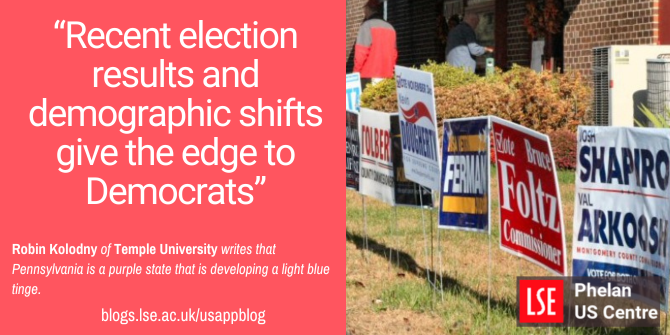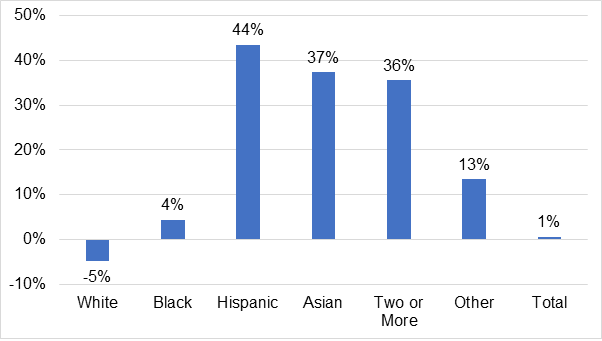 In a 2020 presidential debate with Joe Biden, the then President Donald Trump said, “Bad things happen in Philadelphia.” With Pennsylvania being one of the key swing states in the 2024 presidential election, Robin Kolodny looks at the state’s recent electoral history and the population shifts which may not be favorable for Republicans in November.
In a 2020 presidential debate with Joe Biden, the then President Donald Trump said, “Bad things happen in Philadelphia.” With Pennsylvania being one of the key swing states in the 2024 presidential election, Robin Kolodny looks at the state’s recent electoral history and the population shifts which may not be favorable for Republicans in November.
- This article is part of ‘The 2024 Elections’ series curated by Peter Finn (Kingston University). Ahead of the 2024 election, this series is exploring US elections at the state and national level. If you are interested in contributing to the series, contact Peter Finn (p.finn@kingston.ac.uk).
Once again, Pennsylvania looks to be a swing state for the 2024 presidential elections. In 2020, the state narrowly went for Democrat Joe Biden (+80,555 votes) after having delivered a win for Republican Donald Trump by an even smaller margin in 2016 (+43,292). As of this writing, eight months before Election Day, polls in Pennsylvania show Trump and Biden in a statistical dead heat.
In 2020, while Joe Biden won the state, Democratic Attorney General Josh Shapiro (elected governor in 2022) was also reelected but with 3,243 more votes than Biden! But roll off (when voters only vote for the person at the top of the ticket and ignore down-ballot races) led to the perverse result of having Republicans defeat the incumbent state treasurer and state auditor general, as Democratic voters either did not complete their ballots or chose minor party candidates further down the ticket.
Lessons from Pennsylvania’s recent electoral past
Yet, Pennsylvania is a purple state that is developing a light blue tinge. Let’s look at what happened in the state in 2022. That’s when Democratic Governor Josh Shapiro was elected in a race that was not close (56 to 42 percent) and not predicted to be. Republicans chose a gubernatorial nominee that even they couldn’t stomach. State Senator Doug Mastriano, who chartered busses for the January 6th insurrection, repelled even his own voters.
Then, there was the 2022 US Senate race between current Democratic Senator (and former Lt. Governor) John Fetterman and Republican nominee Dr. Mehmet Oz, a celebrity health guru discovered by Oprah Winfrey. Fetterman had a stroke during the campaign, yet the nationally syndicated health show host could not take advantage of his opponent’s diminished capacity. This was partly due to the successful effort to portray Oz as a carpetbagger who was a resident of the neighboring state of New Jersey, by TV and social media star “Snooki”. The clip went viral and inspired many other such free media messages. Though this race was much closer than the gubernatorial contest, Democrats still led by 5 percent. In a surprise to many, Democrats also reclaimed control of the lower state house for the first time in 12 years, selecting Joanna McClinton as Speaker, the first Black woman to ever hold this position.
In 2024, we have a rematch on the presidential part of the ticket, and a contest for the other US Senate seat. Incumbent Democratic Senator Bob Casey, Jr. is seeking a fourth term. His likely Republican opponent is David McCormick who narrowly lost the nomination for the other senate seat to Dr. Oz in 2022. Then, the state Republican party chose not to endorse any candidate. This past fall, they reversed themselves and endorsed McCormick for the 2024 contest six months before the primary election will be held.

“20151103-LPTwpPA-ElectionDay (7Edit)” (CC BY-NC-ND 2.0) by sanatoga
While McCormick is an attractive candidate with national support, there is no question that Senator Casey’s campaign will be pivotal in 2024. The Casey family has a long history of representing the typical Pennsylvanian: a pro-life Catholic with liberal labor values. Casey has enjoyed comfortable reelection margins since his first election in 2006. In 2012, when he last ran for reelection in a presidential year, he outperformed President Obama (who won the state) by over 31,000 votes (two percent better than the president). In addition to his own ties, Casey can expect significant help from the new governor, Josh Shapiro, who is an incredibly savvy politician with an eye on bigger things for himself. The 2024 elections put a lot on the line for him and he will try hard to deliver. Likewise, Biden and Casey will run a coordinated campaign that should increase turnout.
Pennsylvania’s voting wars
Starting in 2016, Donald Trump implied that Pennsylvania was a prime example of where voter fraud was rampant. There has not been any evidence of this despite vigorous efforts by Republicans in the state to prove otherwise. After the 2020 elections, the state Republican party challenged the validity of all mail-in ballots in the state, hoping to diminish the Democratic vote. Despite making a dramatic appeal to the US Supreme Court, Justice Samuel Alito (who administers PA’s circuit) declined to issue an emergency stay on the counting of these ballots without comment.
In September of 2023, Governor Shapiro announced an administrative change in how citizens were given the opportunity to register to vote when they obtained or renewed their driver’s license. Previously, citizens were asked if they wished to register. Only if they said yes did a voter form appear on their electronic console. This is known as the “opt in” method. Now, the voter registration form will automatically appear on a computer screen. Citizens can decline filling out the form, or “opt out.” However, fewer people do that based on evidence in other states. Republicans vigorously opposed this change and are currently suing to have it stop, but in the first four months of the opt out system, voter registration has increased statewide, and has actually benefitted Republicans more than Democrats.
Figure 1 – Pennsylvania population change by race/ethnicity 2010-2020

Yet population shifts in the state are not favorable to Republicans. The rural areas which gave Trump his biggest pockets of support are diminishing rapidly. Population projections highlight the need for long-term solutions to sustain rural Pennsylvania. The trend for growth of non-Hispanic whites in the state is negative, with big growth in Latino and Asian populations, as Figure 1 shows. The southeast area of the state, commutable to much of the eastern seaboard, is seeing population growth while the northern, central, and western areas continue to decline.
While I expect that both the presidential and senatorial contests will be fiercely contested by the candidates, their super PAC supporters and the political parties, recent election results and demographic shifts give the edge to Democrats. Republicans have not succeeded in curbing the use of mail-in ballots where Democrats have a clear edge. Also, due to the harassment of poll workers during and following the 2020 elections, the state is struggling to staff in-person polling places.
Will Republican voters have the same enthusiasm for Trump in 2016? Will they stay in long lines to vote in-person or will they disagree with Trump that mail-in voting is fraudulent and vote that way? We will all be looking for answers to these questions in the coming months.
- Please read our comments policy before commenting.
- Note: This article gives the views of the authors, and not the position of USAPP – American Politics and Policy, nor the London School of Economics.
- Shortened URL for this post: https://wp.me/p3I2YF-dGc






